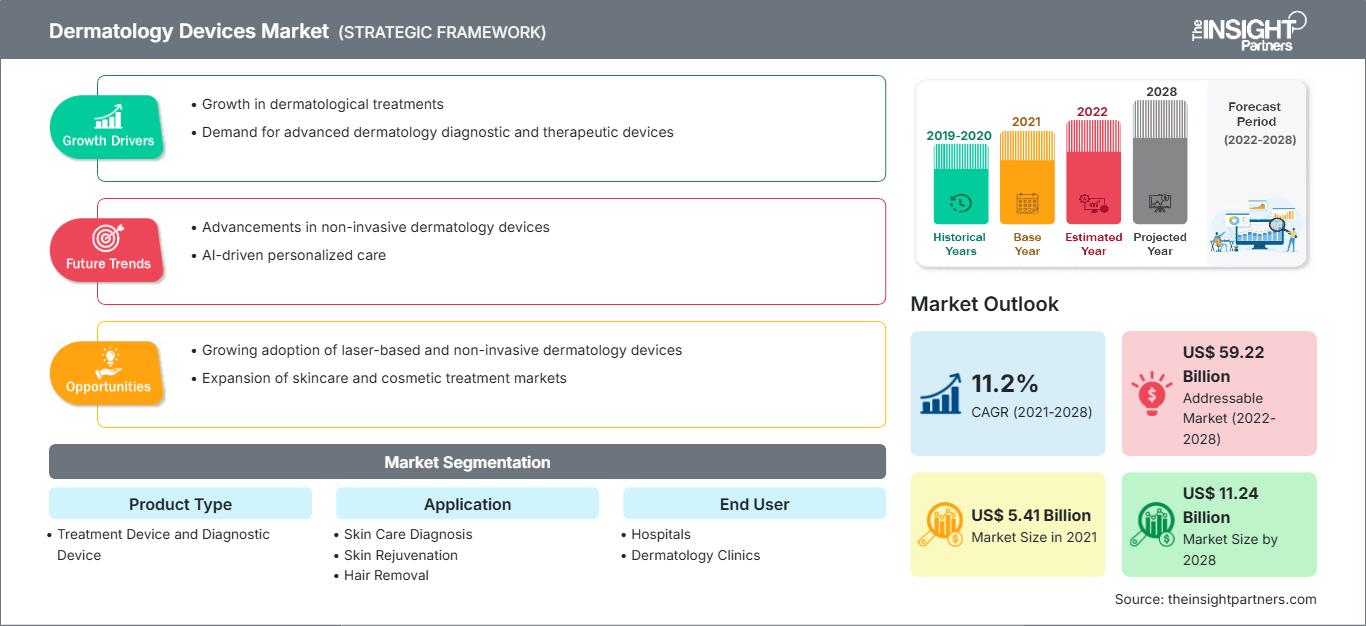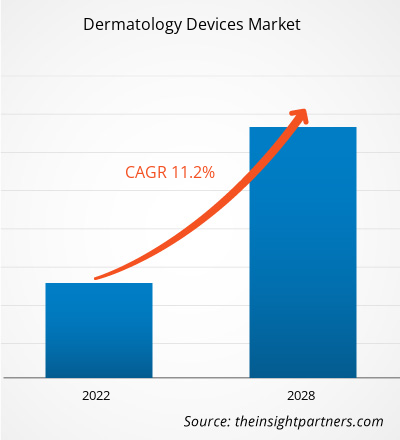El mercado mundial de dispositivos dermatológicos se valoró en 5.408,57 millones de dólares estadounidenses en 2021; se estima que crecerá a una tasa de crecimiento anual compuesta (TCAC) del 11,2% entre 2022 y 2028.
El informe destaca las tendencias predominantes en el mercado de dispositivos dermatológicos y los factores que impulsan su crecimiento. La dermatología abarca el uso de una amplia gama de dispositivos médicos para realizar procedimientos dermatológicos cosméticos y médicos. Estos dispositivos ayudan en el diagnóstico y tratamiento de diversos trastornos de la piel, como el cáncer de piel y la psoriasis. También se utilizan para criocirugía, terapia fotodinámica, cirugía micrográfica de Mohs y electrodesecación y curetaje. La Administración de Alimentos y Medicamentos (FDA) desempeña un papel fundamental en la regulación, aprobación y vigilancia poscomercialización de estos dispositivos, garantizando su seguridad y eficacia.
El informe ofrece información y un análisis exhaustivo del mercado global de dispositivos dermatológicos, haciendo hincapié en diversos parámetros, como las tendencias del mercado, los avances tecnológicos, la dinámica del mercado y el análisis del panorama competitivo de los principales actores. También incluye el impacto de la pandemia de COVID-19 en el mercado en todas las regiones. La COVID-19 tuvo un impacto mixto en el mercado global de dispositivos dermatológicos. Los sistemas de salud se vieron sobrecargados durante esta crisis sanitaria mundial, y la prestación de atención médica a todos los pacientes se convirtió en un desafío clave en muchas regiones. Además, con el avance de la pandemia de COVID-19, las empresas de dispositivos médicos tuvieron dificultades para gestionar sus operaciones. Muchos fabricantes de dispositivos dermatológicos con operaciones comerciales en EE. UU. se vieron afectados negativamente por el brote generalizado de la enfermedad. Sin embargo, tras la relajación de las restricciones por la pandemia en respuesta a la disminución del número de casos, la cantidad de procedimientos estéticos realizados por dermatólogos volvió a la normalidad, ya que los hospitales comenzaron a reanudar los procedimientos electivos, lo que impulsó la demanda de dispositivos dermatológicos.
Obtendrá personalización gratuita de cualquier informe, incluyendo partes de este informe, análisis a nivel de país y paquetes de datos de Excel. Además, podrá aprovechar excelentes ofertas y descuentos para empresas emergentes y universidades.
Mercado de dispositivos dermatológicos: Perspectivas estratégicas

-
Obtenga las principales tendencias clave del mercado que se describen en este informe.Esta muestra GRATUITA incluirá análisis de datos, que abarcarán desde tendencias de mercado hasta estimaciones y pronósticos.
Mercado de dispositivos dermatológicos: análisis geográficos
Geográficamente, el mercado mundial de dispositivos dermatológicos se segmenta en Norteamérica (EE. UU., Canadá y México), Europa (Alemania, Reino Unido, Francia, Italia, España y el resto de Europa), Asia Pacífico (China, Japón, India, Corea del Sur, Australia y el resto de Asia Pacífico), Sudamérica y Centroamérica (Brasil, Argentina y el resto de Sudamérica y Centroamérica) y Oriente Medio y África (Arabia Saudita, Sudáfrica, Emiratos Árabes Unidos y el resto de Oriente Medio y África).
Perspectivas del mercado
Prevalencia creciente del cáncer y los trastornos de la piel
Según un informe de la Academia Estadounidense de Dermatología (AAD), el cáncer de piel es el tipo de cáncer más frecuente en Estados Unidos. Se estima que cada día se diagnostican más de 9500 casos de cáncer de piel en EE. UU. La mayoría de los casos corresponden a cánceres de piel no melanoma (CPNM), que afectan a más de 3 millones de estadounidenses anualmente. Las mujeres presentan la mayor incidencia de CPNM, con tasas que aumentan entre la población joven. El costo anual del tratamiento del cáncer de piel en EE. UU. se estima en 1800 millones de dólares, de los cuales 4800 millones corresponden a CPNM y 3300 millones a melanoma. Además, un informe de Frontiers SA indica que la prevalencia del cáncer de piel es una tendencia global. La biopsia de piel y la evaluación histopatológica son esenciales para confirmar el diagnóstico. Por ejemplo, el desarrollo de tecnologías, métodos y dispositivos de imagen para el registro y análisis de datos ha avanzado rápidamente. Los dispositivos de imagen dermatoscópica proyectan luz sobre la dermis superior para observar y registrar cambios detallados en la pigmentación. Además, el desarrollo de dispositivos de diagnóstico no invasivos de alta resolución, como la microscopía confocal y la microscopía multifotónica, que permiten detectar lesiones cutáneas a nivel celular sin necesidad de biopsia, ha tenido una gran acogida en el mercado. Estos avances innovadores contribuyen eficazmente al diagnóstico del cáncer de piel, a la interpretación precisa de los cambios en lesiones sospechosas y a la efectividad de la cirugía de seguimiento.
Los trastornos de la piel constituyen un problema importante a nivel mundial entre adolescentes y adultos. El acné, la psoriasis y la rosácea se encuentran entre los trastornos cutáneos más comunes. Cabe destacar que el acné es el trastorno cutáneo más frecuente, afectando a hasta 50 millones de estadounidenses anualmente, según estimaciones de la Academia Americana de Dermatología (AAD). Además, aproximadamente 7,5 millones de personas en Estados Unidos padecen psoriasis, principalmente en adultos, con la mayor proporción entre los 45 y los 64 años. Asimismo, la rosácea es una enfermedad cutánea común que afecta a 16 millones de estadounidenses anualmente, según un informe publicado por la AAD. El diagnóstico de estos trastornos cutáneos puede realizarse eficazmente mediante inteligencia artificial (IA). Estos factores ofrecerán oportunidades lucrativas para el mercado global de dispositivos dermatológicos durante el período 2022-2028.
Mercado de dispositivos dermatológicos: información basada en productos
Según el tipo de producto, el mercado mundial de dispositivos dermatológicos se divide en dispositivos de tratamiento y dispositivos de diagnóstico. El segmento de dispositivos de tratamiento representó la mayor parte del mercado en 2021.
Mercado de dispositivos dermatológicos: perspectivas basadas en aplicaciones
Según su aplicación, el mercado mundial de dispositivos dermatológicos se segmenta en diagnóstico de cáncer de piel, rejuvenecimiento cutáneo, depilación, remodelación corporal y reafirmación de la piel, psoriasis y otros. El segmento de diagnóstico de cáncer de piel ostentó la mayor cuota de mercado en 2021.
Perspectivas regionales del mercado de dispositivos dermatológicos
Los analistas de The Insight Partners han explicado en detalle las tendencias regionales y los factores que influyen en el mercado de dispositivos dermatológicos durante el período de previsión. Esta sección también analiza los segmentos y la geografía del mercado de dispositivos dermatológicos en Norteamérica, Europa, Asia Pacífico, Oriente Medio y África, y Sudamérica y Centroamérica.
Alcance del informe de mercado de dispositivos dermatológicos
| Atributo del informe | Detalles |
|---|---|
| Tamaño del mercado en 2021 | 5.410 millones de dólares estadounidenses |
| Tamaño del mercado para 2028 | 11.240 millones de dólares estadounidenses |
| Tasa de crecimiento anual compuesto global (2021 - 2028) | 11,2% |
| Datos históricos | 2019-2020 |
| período de previsión | 2022-2028 |
| Segmentos cubiertos |
Por tipo de producto
|
| Regiones y países cubiertos |
América del norte
|
| Líderes del mercado y perfiles de empresas clave |
|
Densidad de los participantes en el mercado de dispositivos dermatológicos: comprensión de su impacto en la dinámica empresarial
El mercado de dispositivos dermatológicos está creciendo rápidamente, impulsado por la creciente demanda de los usuarios finales debido a factores como la evolución de las preferencias de los consumidores, los avances tecnológicos y una mayor conciencia de los beneficios del producto. A medida que aumenta la demanda, las empresas amplían su oferta, innovan para satisfacer las necesidades de los consumidores y aprovechan las nuevas tendencias, lo que impulsa aún más el crecimiento del mercado.

- Obtenga una visión general de los principales actores del mercado de dispositivos dermatológicos.
Mercado de dispositivos dermatológicos: perspectivas basadas en el usuario final
Según el tipo de usuario final, el mercado mundial de dispositivos dermatológicos se segmenta en hospitales, clínicas dermatológicas y otros. El segmento hospitalario representó la mayor cuota de mercado en 2021. Sin embargo, se prevé que el segmento de clínicas dermatológicas experimente el mayor crecimiento anual compuesto (CAGR%) durante el período 2022-2028.
Alma Lasers (Sisram Medical), Cutera Inc., Candela Corporation, Solta Medical (Bausch Health Companies Inc.), FotoFinder Systems, Cynosure, Lumenis, El.En SpA, Leica Microsystems y Aerolase Corp. se encuentran entre los principales actores del mercado mundial de dispositivos dermatológicos. Estas empresas han implementado estrategias de crecimiento orgánico, como el lanzamiento y la expansión de productos, para ampliar su presencia y cartera de productos a nivel global.
- Análisis histórico (2 años), año base, pronóstico (7 años) con CAGR
- Análisis PEST y FODA
- Tamaño del mercado, valor/volumen: global, regional y nacional
- Industria y panorama competitivo
- Conjunto de datos de Excel
Informes recientes
Testimonios
Razón para comprar
- Toma de decisiones informada
- Comprensión de la dinámica del mercado
- Análisis competitivo
- Información sobre clientes
- Pronósticos del mercado
- Mitigación de riesgos
- Planificación estratégica
- Justificación de la inversión
- Identificación de mercados emergentes
- Mejora de las estrategias de marketing
- Impulso de la eficiencia operativa
- Alineación con las tendencias regulatorias






















 Obtenga una muestra gratuita para - Mercado de dispositivos dermatológicos
Obtenga una muestra gratuita para - Mercado de dispositivos dermatológicos